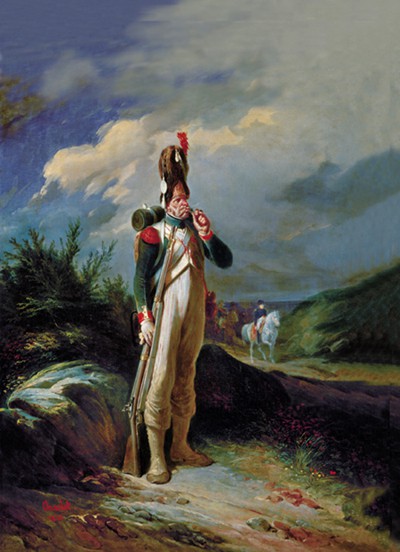In his Abécédaire moral et philosophique à l'usage des grands et des petits enfants (published in 1835 in Paris by Gihaut), Charlet wrote that “the 'grognard' is a 'vieux brave' who is constantly dissatisfied, and is content to remain that way because such a state pleases him”. The sullen expression, as well as the pipe and the fur hat, have become inseparable from the image of the Grenadier de la Garde. His uniform is accurately detailed; Charlet, who was 23 at the fall of the Empire in 1814, was well acquainted with the soldiers of the Grande Armée and used them and their uniforms as models in his compositions. Charlet was the son of a Republican dragoon, and the imperial victories fueled his patriotism and, With the return of the Bourbons to the throne, his nostalgia for the imperial splendour. Charlet's representations of Napoleon's soldiers are more imposing, seeking, as he was, to create a very specific sort of man: one of experience, with a craggy forehead and a distant but resolute expression.
The character's determination is allied with Charlet's energetic, bold strokes that are evident in this canvas, which displays touches of his apprenticeship (begun in 1817) with Jean-Antoine Gros (1771-1835). Encouraged by his master and keen to paint quickly when the moment took him, Charlet was able to give free rein to his talent through his use of the lithographic method. However, this technique did not always allow him to freely express his artistic temparement and he was often dissatisfied with the end-result. He had no reason to be, though, as his lithographs display all the verve and vigour that are to be found in his canvases. His landscapes, a constant in all his work, are particularly well-executed.
Under this imposing sky can be seen a small figure; this is Napoleon. Despite the distance, the Emperor is immediately recognisable. Charlet depicts here only the essential, indeed the very essence of Napoleon: his destiny. This work figures prominently in the Napoleonic legend, the construction of which took place during this period, particularly with the publication of the Mémorial de Sainte-Hélène (1842). The Grenadier de la Garde, imposing and determined, watches over the legend and the cult of the Emperor.
Elodie Lerner (tr. & ed. H.D.W.)
March 2009
The Grenadier de la Garde
Artist(s) : CHARLET Nicolas-Toussaint

- Date :
- 1842
- Technique :
- Oil on canvas
- Dimensions :
- H = 81.5 cm, L = 65.2 cm
- Place held :
- Paris, Musée du Louvre
- Photo credit :
- © RMN

